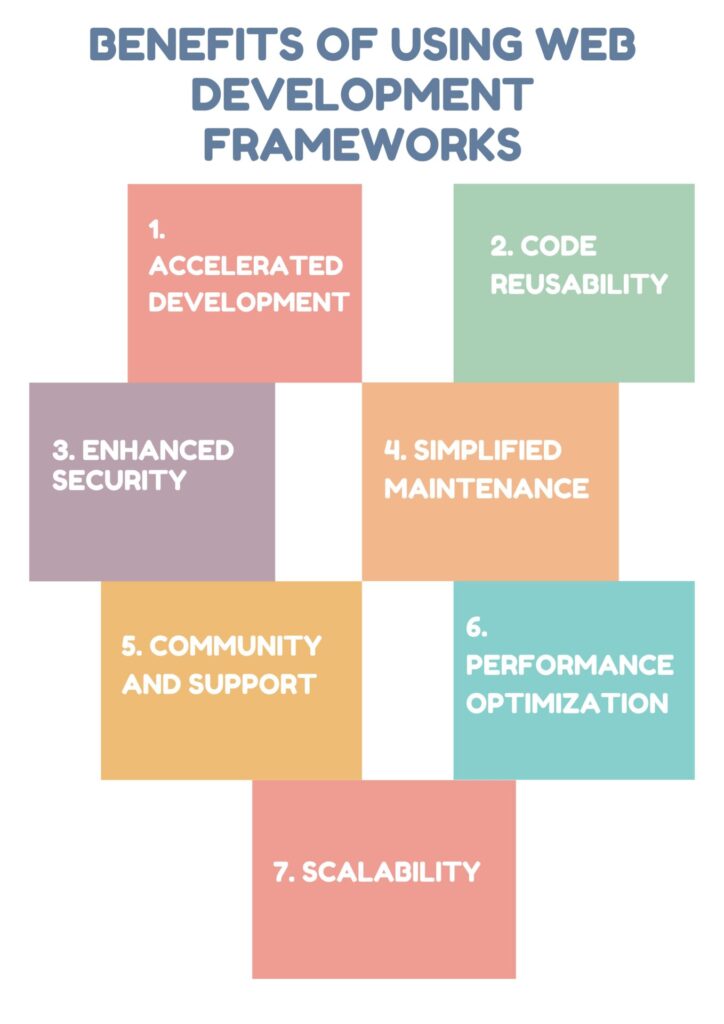What Are Web Development Frameworks? Learn about web frameworks and tools that are used to design webs and web applications by using sets of components and structures. Know more about Front-end and back-end frameworks. This article also teaches you the advantages of using the framework and how to select the appropriate one.
Introduction
Web development frameworks are useful resources that developers can rely on to build websites and web applications. These frameworks have libraries and components as well as a set of architectures and industry standards already in place so that developers do not need to start from building the basics. It was classified based on the front-end frameworks, such as react and angular and the back-end frameworks, such as Django and Express. Js are used to enhance the process of development, make code maintenance easier and increase the effectiveness of web projects.
What are web development frameworks?
Web development framework refers to the toolbox containing several requirements, programs and other tools required by software developers to develop, maintain and run web applications, websites and web services, including developing APIs. These frameworks, or web application frameworks or simply web frameworks, offer a structure for development on known technology platforms such as Linux, Apache, MySQL and PHP (LAMP). As such, web development frameworks enhance the ease of developing fully functional applications with the help of many features and functions due to the complexity of present-day web development.
Types of Web Development Frameworks
Web development frameworks are categorized into two main types: As for the division of frameworks, there are front-end frameworks and back-end frameworks. These are planned for a specific stage of development, and at times, the two are used together for the creation of full-stack Web Applications.
1. Front-End Frameworks
Front-end frameworks are concerned with the client side of a web application relative to the look-and-feel as well as the interactions of a website or web application. These frameworks are at the heart of displaying content in the user’s browser and providing a user-friendly experience. Some popular front-end frameworks include: Some popular front-end frameworks include:
- React: Written by Facebook, React is a JavaScript library used to create UI components for applications that are mainly single-page applications. Version 3 used a component-based architecture, Which enables the developers to create reusable UI components.
- Angular: Developed and maintained by Google, Angular is a full-stack framework that provides all that is needed to develop modern applications. It consists of a data binding system function for data synchronization between the model and the view, dependency injection and also has a good framework for large applications.
- Vue. js: Vue. Js is yet another progressive JavaScript framework that can be easily integrated into projects. It is mainly concerned with the construction of user interfaces and single-page applications and provides flexibility as well as simplicity.
2. Back-End Frameworks
Full-stack frameworks are responsible for server-side scripting where most of the applications’ functionality, such as business logic, database management, user authorization, and overall design of the Web application, are implemented. They offer all that is required when it comes to controlling all the server-side processes and data. Some widely used back-end frameworks include: Some widely used back-end frameworks include:
- Django: A Python framework at a high level that encourages the fast-paced creation of code and pragmatic, easily readable structures. The web framework Django is attributed to having the ‘batteries included’ approach that comes with features that include an admin panel, authentication and an ORM.
- Ruby on Rails: Also known as Ruby on Rails, this framework is a Ruby language that emphasizes the principles of suggested configuration, consequently allowing users to create applications faster with fewer lines of code. It also comes with built-in solutions for practically any activity you might come across, such as database migration and web services.
- Express. Js: A bare-bones diagram and fluid Node. Js framework, Express. Js offers a minimal set of basic functionalities needed in developing web apps. While it is very useful for creating APIs and SPA, it is not so effective for building large applications with complex views.
3. Full-Stack Frameworks
Full-stack frameworks are those that support both the front-end and back-end development to foster the complete environment to develop web applications. Some examples of full-stack frameworks include: Some examples of full-stack frameworks include:
- Laravel: A PHP-based development framework that provides an elegant syntax along with powerful tools for the implementation of routes, user authentication and templates. Laravel has received much attention because of its philosophy of developing with developers and a strong supporting community.
- ASP. NET Core: A cross platform framework for creating new Web applications by Microsoft based on client-side technologies. It covers the creation of the front-end and back-end features, thus making it a one-stop-shop for web development.
- Ruby on Rails: Rails, for the most part, is a backend framework, but it does possess many elements that support front-end development, which makes Rails a full-stack framework solution for Rubyists.
When deciding on the WDF, it is crucial to classify the frameworks depending on which part of the website they are designed for front-end, back-end or both full. Selecting the right framework involves a close look at factors such as scalability, performance as well as the developers’ expertise in that framework.
Benefits of Using Web Development Frameworks
Web development frameworks have numerous advantages, which would prove valuable if implemented in Web applications for increasing their efficiency and security and work on maintaining the framework. Here are some of the key advantages: Here are some of the key advantages:

1. Accelerated Development
Web development frames work creates a standardized environment that acts as templates that facilitate web developers to come up with a new web application without having to start from basic elements such as building, designing, and implementing the application from start to finish. The use of such constructs as templating engines, form handling, and even database abstraction layers helps to cut down the need to code a lot of standard functionalities over and over again.
2. Code Reusability
Reusability is the ability of frameworks to supply block mechanisms, which can be reused in various portions of an application, as well as in different projects. It is also efficient since repeated elements can be used, and this slashes time as well as eliminates opportunities for mistakes since tried and tested parts are used.
3. Enhanced Security
Security is a major issue when it comes to web development, and one of the major advantages of frameworks is that it means you can have security considerations built into the framework to prevent certain commonly seen problems such as XSS, CSRF and SQL injection attacks. Such incorporated safeguards help guarantee that a programmer practices secure programming without having to incorporate subroutines of security individually.
4. Simplified Maintenance
Frameworks provide a strict structure to be followed to code so it becomes very easy to maintain and even upgrade web applications. This structured approach firstly improves interteam cooperation as the codebase has a clear structure that is easier to follow for new developers.
5. Community and Support
The vast majority of the modern popular frameworks are open-sourced, which means that numerous people participate in the frameworks’ continuous updates, provide assistance, and develop additional tools and modules. This implies that developers are in a position to locate solutions to regular issues and problems, a rich documentation and get to enjoy extra resources developed by other great developers.
6. Performance Optimization
Web development frameworks may comprise a number of tools and guidelines that can be used in the enhancement of the performance of web applications. For instance, they can offer the quickest ways of querying databases, applying caches, and organizing assets that allow for quicker loading of a page by the user.
7. Scalability
Frameworks are developed for the growth of web applications. Frameworks ensure that as your application grows, you have an arsenal of tools to handle the growing number of users or flows of data, the database and the traffic to your server. This helps in making sure that your application does not experience a lot of instabilities and downtimes at your growth stage.
Choosing the Right Web Development Framework for Your Project
Choosing the right Web Development Framework is, therefore an important consideration because it determines the success, scalability and maintainability of the Web Application. There are a bunch of such frameworks, and every one of them is unique, has its advantages, and may have some drawbacks; the choice is up to certain factors related to the particular project.
1. Project Requirements
There are some basic guidelines to follow, but first, you should get an idea of the needs of your particular project. It is important to determine whether you need only an FE framework or a BE framework or if you want to go for the FS framework. For instance, if your project requires a very reactive user interface, you may choose to work with a front-end framework of your choice, such as React or Angular. On the other hand, if you want a more powerful server side solution – Django or Express. Js could be better suited in order to cater to the needs of highly diverse users in the context of the web list serving.
2. Scalability
Think about how well you can expand the framework in the long term. If you foresee your project progressing to add more users and more complex operations after some time, then the framework that you are going to use should have a readiness to expand in scale. Borrowed frameworks such as Angular and Django are popularly recognized for their scalability capabilities in handling big applications.
3. Development Speed
If time to market is the key factor to consider, then one uses a framework that has the benefits of rapid development. Platforms such as Ruby on Rails and Laravel have been developed with support for their applications, which adapt to the needs of developers. These frameworks have a number of in-built components that contribute a lot to cutting down the time of coding.
4. Community and Support
Community involvement is also an added advantage when carrying out a framework. Engaging communities may lead to the creation of a lot of documentation, tutorials and plugins that can be useful in development and can solve many problems. Utilities like React, Angular and Laravel have such a behemoth backing that there are immense amounts of support that can be had.
5. Learning Curve
Another factor that needs to be taken into consideration is its learning curve which might be steep in case your team had no previous experience with the framework. Some frameworks, like Vue. Since Js and Flask are relatively easy to use, they can be used by developers who are not familiar with various frameworks. However, using complex frameworks such as Angular or Spring will take more time as well as training.
6. Security
Secure features are one of the most important needs for web applications, especially when dealing with customer information. Some frameworks have security features integrated into their architectures; these include CSRF protection, encryption and validation that makes secure coding faster and less risky. For instance, Django is well recognized for the high degree of caution it takes towards security principles.
7. Ecosystem and Compatibility
Quantitatively measure the external factors that would surround the framework, such as the number of third-party libraries, plugins, and tools, among others. Other considerations include the compatibility of the chosen technology with others, for example, databases, front-end frameworks and APIs. For instance, ASP. NET Core is nicely aligned with the Microsoft environment therefore, it is quite good for projects which utilize other Microsoft tools.
8. Cost and Licensing
Check the licenses of the framework as well as the cost. Some of these frameworks are available in the public domain and, as such, are available for use without charge, whereas others come with certain costs known as licensing fees. Make sure that the framework you compare relates to your project’s finances and the law.
FAQ’s
Though not mandatory, utilizing a framework proves rather critical in that it cuts on the time used in developing an application, reduces the incidence of error occurrences, and is almost guaranteed to have employed the best practice methods; thus, any project would reap large benefits from using a framework.
Some of the well-known front-end frameworks are React, Angular, and Vue. Js, both of which provide ever-changing features for the creation of user interfaces.
Popular back-end frameworks include Django for Python, Laravel for PHP and Express for Node.js. Js (Node. js), each that has powerful tools for server-side development.
Indeed, it is quite typical to frequently employ a different framework when it comes to the front-end and back-end of a project. For instance, while you’ll develop the user interface using React, for the server-side tasks, you will use Django.
Web development frameworks offer the necessary tools and infrastructure to develop a new web application from scratch. At the same time, a CMS such as WordPress is a ready-made platform to manage content with little or no coding involved.
Conclusion
Web development frameworks are important resources that help developers create general structures that allow them to construct web-based applications and websites. It includes construction elements and libraries together with best practices for development since it can enhance security features and the overall scalability of applications. Picking out the front-end, back-end, or full-stack helps the developers select the most appropriate framework depending on the requirements of the project. Frameworks are one of the essentials of modern Web development, as, for example, React helps in building a smooth and easily changing UI or Django, which lets optimize server-side logic and, respectively, the speed of the website in general.




